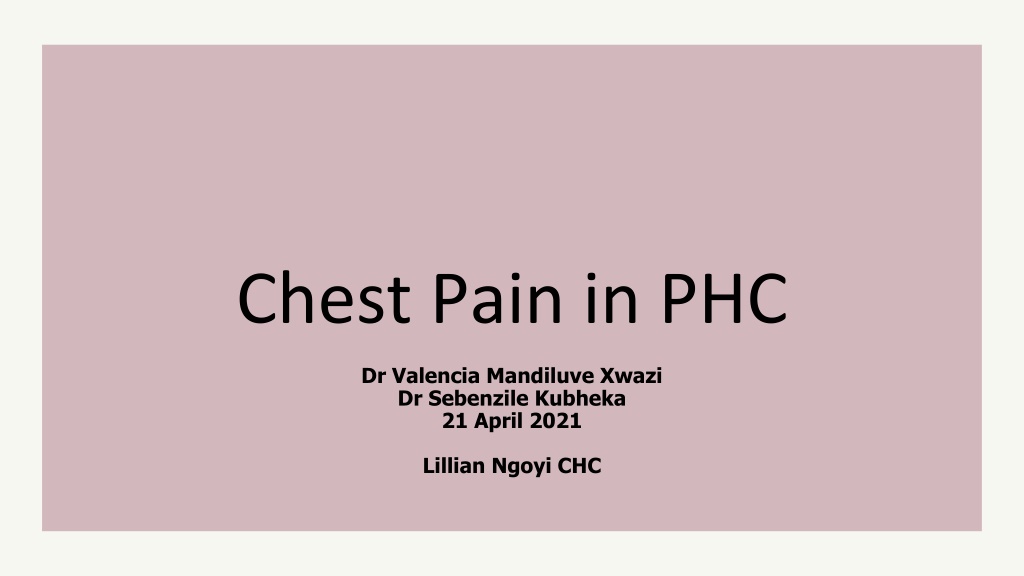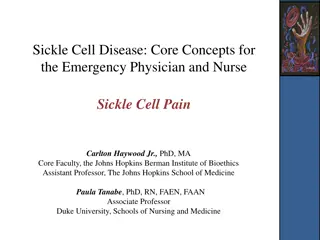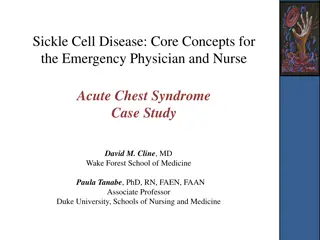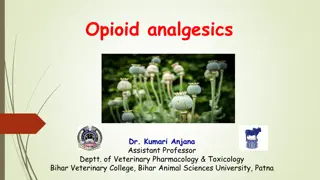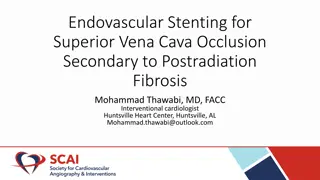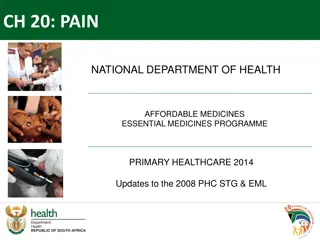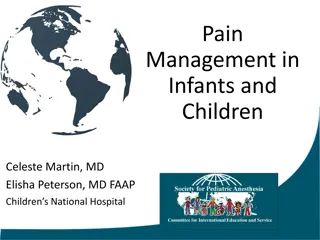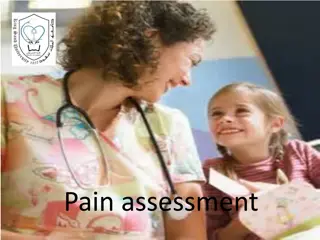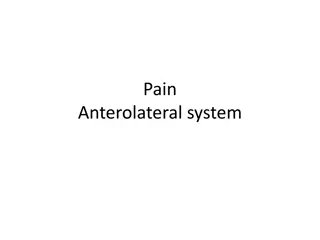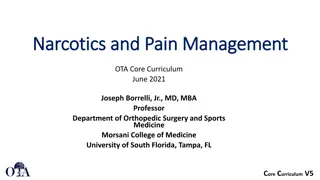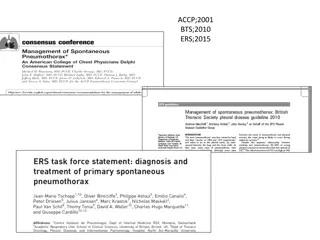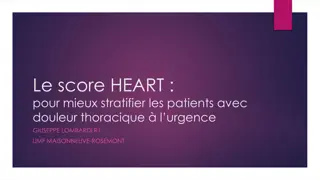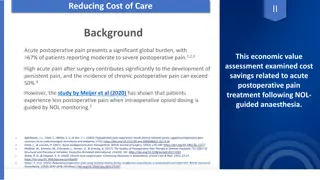Understanding Chest Pain Management at Primary Healthcare Level
Chest pain is a common presentation requiring swift identification and management to distinguish life-threatening causes like Myocardial Infarction. This article focuses on the approach to chest pain at a primary healthcare level, detailing cardiac and non-cardiac causes, recognizing urgent cases, and highlighting the top 5 life-threatening conditions that require immediate attention.
Download Presentation

Please find below an Image/Link to download the presentation.
The content on the website is provided AS IS for your information and personal use only. It may not be sold, licensed, or shared on other websites without obtaining consent from the author. Download presentation by click this link. If you encounter any issues during the download, it is possible that the publisher has removed the file from their server.
E N D
Presentation Transcript
Chest Pain in PHC Dr Valencia Mandiluve Xwazi Dr Sebenzile Kubheka 21 April 2021 Lillian Ngoyi CHC
Content Limitations Definition of Chest Pain Approach to Chest Pain at a PHC level Life Threatening Causes of Chest Pain & Management Non Life Threatening Differential Diagnosis of Chest Pain & Management Conclusion Recommendations References
Limitations Our Topic is limited to PHC level, therefore the approach to Chest Pain and the Management of the conditions is based on PHC management guidelines up to the point of referral to hospital. Some hospital level resources and material were consulted in order to expand on the topic for learning purposes. Chest Pain as a clinical presentation at PHC was a broader topic, so we focused more on the Life Threatening causes and put more focus on Myocardial Infarction because of its importance in the clinical setting...
Definition of Chest Pain A discomfort in the chest/ thorax including a dull ache, a crushing/ burning feeling/ a sharp stabbing pain It can radiate to the neck, jaw arm/ back; It can be cardiac or non cardiac; According to the underlying cause; and these range from immediately life threatening to the trivial. Chest pain is a common presentation on the CHC and it s important as a health professional to be able to exclude the life threatening causes.
Cardiac & Non Cardiac Causes Cardiac: (Acute Myocardial Infarction, Angina Pectoris) Non Cardiac: (Dissecting Aortic Aneurysm, Massive Pulmonary Embolus, Tension Pneumothorax, Esophageal Rupture, Esophageal reflux, Peptic Ulcer Disease, Pericarditis, Pneumonia, Musculoskeletal Disease- Costocondritis, Emotional and Psychiatric Conditions)
Recognize the patient with Chest Pain needing urgent attention
5 Life Threatening Causes of Chest Pain Myocardial Infarction Dissecting Aortic Aneurysm Massive Pulmonary Embolus Tension Pneumothorax Esophageal Rupture
Patient History OPQRST Onset: What was the patient doing when the pain started Provocation: What makes it better or worse? Quality: Can you describe it? How does it feel like? Radiation: Where do you feel the pain, where else does the pain go? Severity: How bad is the pain on a scale of 1-10? Time: When did the pain start?
Vitals: BP: >/=180/110 Or BP: <90/60 Pulse: Irregular, >100 or <60 Symptoms Severe Chest Pain New onset of central chest pain Pain Spreads to the Neck, Arm or Back Sweating, nausea & Vomiting General Exam: Pale Patient History: DM, Smoker, HPT, Known CVD risk>10%, Known with Ischemic Heart Disease/ immediate family history. Provisional Dx: ACS (MI/ Angina)
Management Route If conscious, sit patient up Give 40% face mask oxygen If BP< 90/60, give 200ml Sodium Chloride 0.9% IV Further Manage according to Temperature >/= 38 degrees C, Chest infection likely < 38 d greed C, Do an ECG If ECG is normal/ unavailable/ uncertain: Is Chest Pain worse on lying down/ palpating/ breathing deeply? If yes to any of the above, Heart attack unlikely, Refer urgently If No to the above question, Heart attack likely- Refer to ACS Management ECG abnormal- Refer to ACS management
Acute Coronary Syndrome Most important due to commonality as well as lethality It s a top differential, first enquirer Includes a range of conditions from Angina to Acute Myocardial Infarction, which vary from patient to Patient, caused by acute myocardial ischaemia 1. Stable Angina 2. Unstable Angina 3. NSTEMI
Acute Myocardial Infarction Onset at Rest, subacute onset (minutes) Severe central chest pain Sweating Anxiety Associated Symptoms ( Nausea & Vomiting) No relief with Nitrates
Physiopathology The Chest Pain of Angina and myocardial infarction are due to the accumulation of metabolites from ischemic muscle following complete or partial obstruction of a coronary artery which leads to stimulation of cardiac sympathetic nerves
Risk Factors Modifiable Obesity Smoking: Significant Smoking History recorded as packet years: The risk of IHD falls gradually over the years after smoking has been stopped. Diet Sedentary Lifestyle High Serum Cholesterol (Hypercholesterolemia): Total serum cholesterol of > 5.2 mmol / L is undesirable Hyperlipidemia: High alcohol consumption and obesity are associated with hyper triglyceride is Non Modifiable Cardiac Transplants: Patients with cardiac transplants may not feel angina, presumably because the heart is denervated Diabetes: Patients with diabetes are likely to be diagnosed with silent infarcts Hypertension: Risk for coronary artery disease especially if no treatment has been instituted
Non modifiable Risk Factors continued... Previous Coronary Disease Family History of Coronary Artery Disease: 1st degree relatives- parents and siblings Chronic Kidney Disease: Related to high calcium-x-phosphate product, needs dietary intervention, phosphate binders, efficient dialysis or renal transplant Chronic Inflammatory Rheumatological Disease- Rheumatoid Arthritis Erectile Dysfunction: Sensitive Indicator of arterial endothelial abnormality Dental Caries: Associated with an increased risk of ischemic heart disease Male sex and advanced age
TIMI Risk Score Risk Stratify the patient Age > 65 >3 Coronary artery Factors Known coronary artery stenosis Use of Aspirin in the last 7 days Elevated cardiac bio markers Severe Angina (>2 episodes in <24 hours) ST depression or elevation> 0.5mm (0-2= low risk; 3-4= medium risk; 5-7= high risk)
Management ACLS Principles Adjuncts
Adjuncts Aspirin 300mg chewed po stat C/I: Known Hypersensitivity Relative C/I: Active PUD; Bleeding Disorder MOA: Non selective COX inhibitor; decreases Thromboxane A2 production by platelets (responsible for platelet aggregation)
Clopidogrel 600mg for both STEMI & NSTEMI ( faster onset of action with higher loading doses, with no increase in S/E MOA: Antiplatelet agent by inhibiting ADP binding to platelet and subsequent activation of GPIIb / IIIa receptor complex
Enoxaparin 30mg IVI stat Then 1mg/kg s/c 15 later MOA: LMWH binds with AT III to form complex inhibits factor Xa and therefore conversion prothrombin - thrombin
Nitroglycerin Nitrous Oxide Donor, Vasodilation 0.5mg S/L every 5 minutes ( max 3 doses) C/I: Hypotention (SBP<90mmHg) ; Severe Bradycardia (HR<50BPM); Severe Tachycardia ( HR> 100BPM); RV infarction (inferior MI); Use on PDE- I
Simvastatin 40mg po stat MOA: anti inflammatory effect with plaque stabilization OtherMedication Morphine for pain Beta Blockers if not contraindicated
Dissecting Aortic Aneurysm Instantaneous onset Radiates to back Very severe pain, Tearing quality Anterior Chest Pain: Proximal Dissection Inter scapular pain: Descending Aorta RF: HPT/Connective Tissue Disorders- Marian s Syndrome & Ehler s- Danlos syndrome Management: Stabilize Patient, Refer to Hospital for Further Management
Massive Pulmonary Embolism PE often occurs without symptoms or signs Sudden and unexplained dyspnoea Pleuritic Chest Pain and Hemoptysis occurs only when there is Infarction Syncope or the sudden onset of severe substernal pain usually occurs with Massive Embolism
Risk Factors Previous PE Immobilization ( Long aeroplane or car trip/ post surgical intervention especially lower limb orthopedic operations) Known clotting- factor abnormalities Known Malignancy
Signs PE General Signs: Tachycardia, tachypnoea, fever (with Infarction) Lungs: Pleural Friction rub if Infarction has occurred Massive Embolism Elevated JVP Right Ventricular Gallop Right Ventricular Heave Tricuspid Regurgitation Murmur, Palpable Pulmonary component of the second heart sound (P2) Gallop (S3 &/ S4)
Wellss Probability Score Clinical signs and symptoms of DVT (minimum of leg swelling and pain with palpating of the deep veins)= 3.0 An alternate diagnosis is less likely than PE= 3.0 Heart Rate > 100 bpm= 1.5 Immobilization at least 3 days, or surgery in previous 4 weeks= 1.5 Previous PE/DVT= 1.5 Haemoptysis= 1.0 Malignancy ( on treatment or treated in the last 6 months, palliative)= 1.0 Interpretation: Low probability: <2.0 Moderate probability: 2.0-6.0 High Probability: >6.0 Can use PERC.
Management Protect Airway Supply oxygen Ensure adequate ventilation, IV Access and Fluid boluses Refer to Hospital Low Risk PE: Passive anti- coagulation with Warfarin until INR (2-3) Massive PE: Inotropic Support Thrombolysis if not contraindicated
Tension Pneumothorax It s a medical emergency This occurs when there s communication between the lung and the pleural space with a flap of tissues acting as a valve, allowing air to enter the pleural space during inspiration and preventing it from leaving during expiration. It results from air accumulating under increasing pressure in the pleural space It causes displacement of the mediastinum with obstruction and kinking of the great vessels
Signs Injuries Tachypnoeic and cyanosis; May be Hypotensive Trachea and Apex beat displaced away from the affected side Expansion reduced or absent on the affected side Hyper-resonant over the affected side Breath sounds absent Vocal Resonance Absent
Causes Trauma Mechanical ventilation at high pressure Spontaneous- Rarely
Management Release Pressure Insert a wide bore IV cannula through the 4th and 5th intercostal space in the anterior ancillary line on the affected side, withdraw the needle and retain the cannula and Refer the patient with until until the hospital where an urgent intercostal drain can be inserted Cover penetrating wounds on the chest with sterile dressing, tape 3 sides of the dressing and leave 1 side untapped.
Esophageal Rupture Are tears that penetrate the wall of the esophagus Rare Ruptures can be caused by surgical procedures, severe vomiting, or swallowing large piece of food, some spontaneous Chest Pain Abdominal Pain Vomiting Hematemesis Hypotension Fever Management: Broad spectrum ABx to prevent infection IV, Fluids to treat low blood pressure High risk death
Non Life Threatening causes of Chest Pain Brief Clinical Differential Diagnosis (Consult Talley & O Connor for clinical signs due to time constraints)
Types of Chest Pain Pressure, Tightness, heaviness and burning ( AMI, Angina) Pressure, Tightness and Burning (Esophageal Spasm) Sharp (Pericarditis) Burning ( Esophageal reflux, Peptic Ulcer, Herpes zoster) Pleuritic (PE, Pneumonia, Pleuritis) Tearing/ Ripping (Aortic Dissection) Aching (Musculoskeletal Disease) Variable (Emotional & Psychiatric Conditions)
Angina Tight/ Heavy moderate pain/ discomfort Onset predictable with exertion Relieved by rest Relieved Rapidly by nitrates Not positional Not affected by respiration No sweating Mild or no anxiety Associated symptoms absent
Management Oxygen 40% Facemask if saturation<94% Aspirin, po 75-100mg as a single dose (chewed or dissolved) as soon as possible If not available, Aspirin 150mg single dose Nitroglycerin. 0.5mg S/L every 5 min max 3 doses Morphine 10mg diluted with 10ml of water for injection or sodium chloride 0.9%, slow IV (Dr initiated) Start with 5 mg, titrations by 1mg /min up to 10 mg Can be repeated after 4-6 hours if necessary, for pain relief Beware of hypotension.
Pericarditis/ Pleurisy Sharp/ stabbing Not exertional Present at rest Positional (worse supine-pericarditis) Affected by respiration (Worse with respiration- Pericardial/ Pleural Rub) Unaffected by nitrates Pleuritic pain relieved by sitting up or leaning forward Management: Antibitics and Analgesia,Requires Hospital Management
Esophageal (acid) Reflux Pain Burning Present at rest Onset maybe supine Not exertional Unaffected by respiration Management: Lansoloc 30 mg po daily for 14 days, Refer Pain persists beyond the 14 days course of therapy
Chest Wall Pain Positional Chest wall tenderness Often worse at rest Prolonged Localised Management: Analgesia and anti- inflammatory (Panado 1g po tds and ibuprofen 400mg po tds NSAIDs contraindicated if PUD/ Gastritis
Conclusion Chest Pain at PHC is a common presentation It s important to recognize patients who need urgent medical attention Acute Coronary Syndromes-AMI is top priority of the 5 Life Threatening causes of Chest Pain due to its commonality and lethality Following the Right Approach to Chest Pain at the PHC level will help us not miss the Golden time for the prompt management of medical emergencies of Chest Pain For proper management of patients it s important to follow the Management guidelines of both Life Threatening and Non Life Threatening causes of Chest pain Remember always that Epigastric Pain/ discomfort is not always Gastritis, it could be a sign for a Medical Emergency, an AMI.
